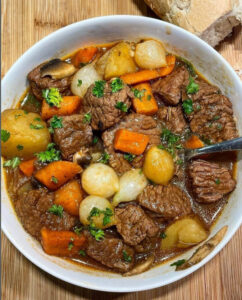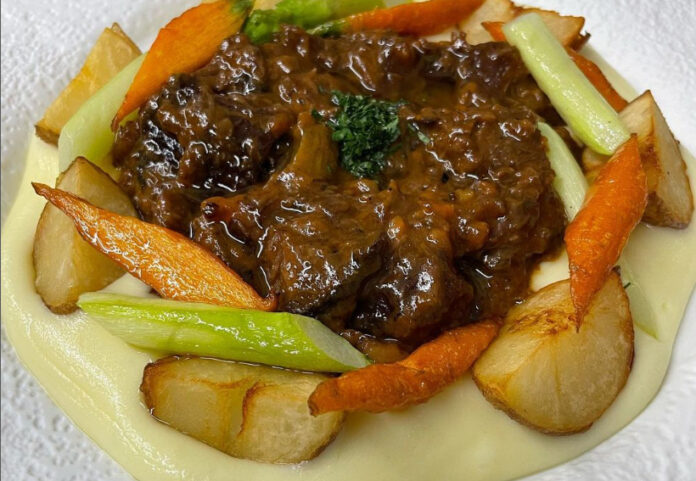In the realm of culinary artistry, the French have achieved unparalleled mastery, and among their treasures, “boeuf bourguignon” shines as a crowning jewel. It’s a dish where beef, bathed in fruity red wine, undergoes a slow, magical transformation into a tender, sticky, and irresistibly savoury delight.
Once described by the celebrated British culinary writer and fervent Francophile, Elizabeth David, as “the domain of French housewives and modest restaurant owners” rather than the domain of professional chefs, boeuf bourguignon has transcended those boundaries in modern times. Now, you’re as likely to encounter its deconstructed form in one of Burgundy’s illustrious Michelin-starred establishments as you are to savour it at your own kitchen table.
“Bourguignon,” quite literally, signifies “of Bourgogne” or Burgundy, that picturesque region nestled in eastern France, between Lyon and Paris, celebrated chiefly for its exceptional wines. Alongside Champagne to the north and its formidable rival, Bordeaux, to the southwest, Burgundy stands tall as one of the world’s most distinguished wine-producing regions. As you journey through this land, you’ll encounter signposts bearing names often found at the tail end of wine lists: charming villages like Mersault and Nuits-Saint-Georges, cradled by meticulously tended vineyards, a green sea as far as the eye can see.
Intriguingly, Burgundian cuisine often mirrors the character of its wines. In the northern reaches, where crisp Chablis wines reign supreme, the fare leans towards delicacy and lightness. In contrast, the southern precincts, known for their buttery whites and robust reds, offer heartier and richer culinary delights. In this realm, you’ll also find the world-famous “poulet de Bresse,” hailed as “the queen of poultry, the poultry of kings” by 18th-century epicurean Jean Anthelme Brillat-Savarin. Yet, southern Burgundy stakes its claim as a producer of some of France’s finest beef. Venture east from Mâcon, and the vineyards eventually yield to pastures graced by the distinctive white Charolais cows, celebrated for their tender, marbled meat.
Typically Burgundian
As expected, alongside Burgundy’s emblematic mustard (Dijon, its capital, has held sway in the French mustard trade since the Middle Ages), beef and wine reign supreme in the Burgundian kitchen, bestowing “boeuf bourguignon” with its authentic terroir essence. Nonetheless, “à la bourguignon” translates to “cooked in the Burgundy style,” inviting a rich tapestry of dishes beyond beef. From eggs to eel, a red wine sauce enrobing mushrooms, baby onions, and bacon lardons can grace the plate.
Interestingly, while “boeuf bourguignon” now proudly stands as one of France’s culinary icons, it didn’t make its debut in Burgundian gastronomy until the 20th century. It wasn’t even considered a regional speciality until then. The earliest documented reference to this dish hails from an 1878 Paris travel guide, suggesting it didn’t initially bask in a glowing reputation. One hypothesis speculates that it might have served as a clever means to repurpose leftover roast meat, resulting in less-than-remarkable offerings. Over time, recipes evolved to embrace fresh beef, sometimes marinated in red wine before cooking. This practice, championed by the late Lyonnaise chef Paul Bocuse, still has its adherents. However, some chefs argue that excessive marination imparts a gamey flavour and renders the meat dry.
Traditionally, a youthful red Burgundy wine is the preferred choice, whether for marination or not. The region predominantly cultivates four primary grape varieties: pinot noir, chardonnay, gamay (the grape behind Beaujolais), and aligoté. Red Burgundy typically showcases pinot noir, while white Burgundy is a tribute to chardonnay.
Selecting the right cut of beef is paramount for slow-cooking success. Fillet or sirloin won’t suffice; you need a cut with ample fat and connective tissue that, given time and gentle heat, will break down, infusing the sauce with sumptuously sticky gelatine while rendering the meat exquisitely tender. Some propose cuts like chuck, shoulder, shin, or cheek. Cheeks, in particular, earn praise for their ability to absorb all the pan’s flavours and surrender to tenderness.
How to make a boeuf bourguignon

The “true” approach to crafting boeuf bourguignon, as per the revered French culinary writer Mapie de Toulouse-Lautrec, involves layering meat and vegetables (typically baby onions and mushrooms, though carrots have become a common addition) in a pot. Pour in the wine and stock, then let it simmer away while you tend to other matters. Modern renditions often introduce a twist, with meat and vegetables browned separately to enrich the dish’s complexity. Some culinary virtuosos even reduce the gravy to a luxuriously thick sauce, bolstered by a generous pat of butter. A splash of cognac is sometimes suggested, though it may not find favour among those loyal to Burgundy’s great rival, Bordeaux.
Indeed, these are but a few of the countless interpretations that boeuf bourguignon has undergone over the years. Even Elizabeth David acknowledged that such a dish doesn’t adhere to a rigid formula; each cook imparts their unique touch. French chef Anne-Sophie Pic adds tandoori spices to her rendition, while Yves Camdeborde introduces notes of chocolate and orange zest. Meanwhile, at Miznon in Paris, boeuf bourguignon has found its home in pita bread. French publication Grazia has even recommended crafting boeuf bourguignon sushi rolls, artfully blending French and Japanese influences. On Jamie Oliver’s website, a vegetarian version swaps beef for mushrooms.
Whether these reinterpretations excite your palate or leave you aghast, rest assured that boeuf bourguignon’s allure remains undiminished. In fact, in a 2017 survey, the French overwhelmingly declared it their favourite national dish. This enduring classic continues to enchant discerning palates and inspire culinary creativity across the globe.


